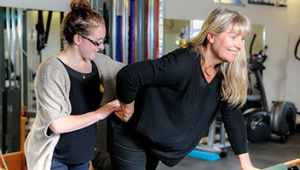
Is the ability to do 300 sit-ups and minutes of plank holds equivalent to having good ‘core strength’? Not necessarily.
In sporting and gym communities ‘core exercises’ generally refers to any exercise targeting the area between your hips and ribs. Often the focus is on bracing and crunches, which certainly work to strengthen the outer layers of the abdominal muscles, however the deepest and arguably most important muscle, the transversus abdominis (TA), is often overlooked. The role of the TA is to support the spine and hold your trunk stable while your limbs are moving. As for any postural muscle, it is the closest to the skeleton and works subconsciously to keep you upright throughout the day. A strong TA allows your limbs to work far more efficiently and improves your coordination and endurance. For example, if you were trying to push somebody over, would you prefer to be standing on solid ground or on a fitball? You have a lot more strength and power when you have something stable under your feet, and the same is true for your legs and arms relationship with your ‘core’. If you watch somebody with poor core stability run, a lot of their energy is wasted on jolting, jarring, and rotation of the trunk rather than propulsion forwards. This also leads to earlier fatigue and can predispose you to injuries.
When you have an injury in any part of your body, the stabilisers stop working as they should. Most footballers can relate to the ankle sprain, and very commonly the sprain recurs on the same side, eventually leading to a ‘weak ankle’. This is because the superficial muscles, or the ‘prime movers’ regain their strength, however the deep stabilisers do not recover unless you specifically retrain them (ie. wobble boards, hopping and landing etc).
When we apply this to a history of back pain, or even an old knee problem which had temporarily altered the way you walk, your core stability is affected. If this is not specifically retrained you put yourself at risk of future problems.
To exercise the TA you need to be aware of the ideal posture, a long spine with shoulder blades down and back and your chin in. It shouldn’t feel as though you are straining. A great way to test it is to lie on your back with knees bent up, feet resting on the ground. Imagine there is a spirit level balancing across the front of your hip bones. Lift your right foot slightly and slowly extend your leg, hovering the foot above the ground, then gently bend back up to the starting position. Repeat this for your left leg and pay attention to what your hips are doing. As you switch sides there should be minimal movement of the spirit level. If it is tipping, you probably need to focus a little more on balance and control in your routine rather than crunching out the 300 sit ups.
There are a great variety of TA exercises that can be prescribed for all levels of athletes. With the right knowledge it can also be worked into your usual routine, and greatly improve your game. At Corio Bay Sports Medicine Centre we have several Physiotherapists who specialise in this area, and can assess your true ‘core’ to help you optimise your running efficiency, improve your balance, relieve pain, and prevent injuries.
